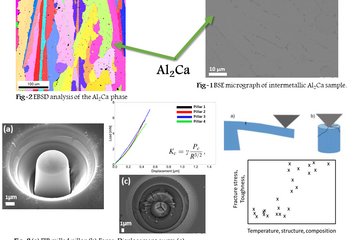All genres
1.
Journal Article
Deep active optimization for complex systems. Nature Computational Science 5 (9), pp. 801 - 812 (2025)
2.
Journal Article
Formation mechanism of brown etching layers in pearlitic rail steel. Materialia 26, 101625 (2022)
3.
Journal Article
Machine learning–enabled high-entropy alloy discovery. Science 378 (6615), pp. 78 - 85 (2022)
4.
Journal Article
Cementite decomposition in 100Cr6 bearing steel during high-pressure torsion: Influence of precipitate composition, size, morphology and matrix hardness. Materials Science and Engineering A: Structural Materials Properties Microstructure and Processing 833, 142372 (2022)
5.
Journal Article
Under-stoichiometric cementite in decomposing binary Fe–C pearlite exposed to rolling contact fatigue. Acta Materialia 216, 117144 (2021)
6.
Journal Article
The role of electric current in the formation of white-etching-cracks. Philosophical Magazine 101 (1), pp. 59 - 76 (2021)
7.
Journal Article
Mechanism of cementite decomposition in 100Cr6 bearing steels during high pressure torsion. Acta Materialia 201, pp. 79 - 93 (2020)
8.
Talk
Machine learning-enabled high-entropy Invar alloy discovery. Accelerated Discovery of new materials, 787 WE-Heraeus-Seminar, Physikzentrum Bad Honnef, Germany (2023)
9.
Talk
Machine learning-enabled fast high-entropy alloy discovery - a case study on novel Invar alloys. DGM workshop:Functional High Entropy Alloys / Hochentropiefunktionswerkstoffe, Bochum, Germany (2022)
10.
Talk
Cementite decomposition in 100Cr6 bearing steel during high-pressure torsion: Influence of precipitate composition, size, morphology and matrix hardness. European Congress and Exhibition on Advanced Materials and Processes, EUROMAT 2021, online (2021)
11.
Talk
Mechanism of cementite decomposition in 100Cr6 bearing steels during high pressure torsion. MSE Congress 2020, virtual, Sankt Augustin, Germany (2020)
12.
Talk
Investigation of cementite dissolution in 100Cr6 bearing steel under high pressure torsion (HPT). Materials Science and Engineering congress, MSE 2020, online, Darmstadt, Germany (2020)
13.
Thesis - PhD
Fundamentals of carbide decomposition and stability. Dissertation, Ruhr-Universität Bochum (2021)










